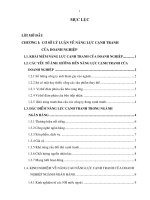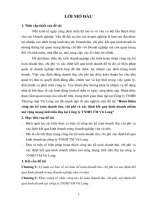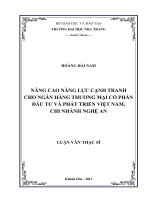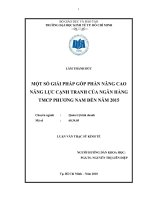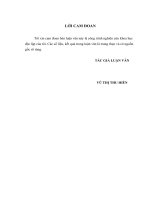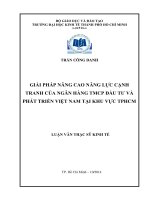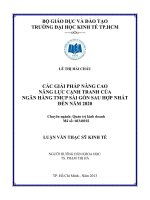Luận văn thạc sĩ nâng cao năng lực cạnh tranh cho ngân hàng agribank
Bạn đang xem bản rút gọn của tài liệu. Xem và tải ngay bản đầy đủ của tài liệu tại đây (1.83 MB, 73 trang )
CAPSTONE PROJECT REPORT
ENHANCE COMPETITIVENESS FOR
VIETNAM BANK FOR AGRICULTURE AND
RURAL DEVELOPMENT IN INTEGRATION
PROCESS (IN 2011-2015 PERIOD)
1.
SUMMARY OF THE STUDY
1.
2.
Summary content of the study
List of figures and tables
2.1 List of main products of Vietnam Bank for Agriculture and Rural Development
2.2 List of abbreviations in the study
2.3 List of references
CHAPTER 1 - RATIONALE OF COMPETITION AND COMPETITIVENESS OF
ENTERPRISE
3
1.1. Competition and competitive capacity
3
1.1.1. Concept of competitive theory of enterprise and concept of competition...3
1.1.2. Role of competition.....................................................................................4
1.2. Competitive capacity 4
1.2.1. Overview of development process of competitive capacity of enterprise. . .4
1.2.2. Concept of competitive capacity of enterprise............................................5
1.2.3. Affecting factors to competitive capacity of enterprise...............................6
1.2.4. Using 5 forces analysis of M.Porter to evaluate competitive capacity of
enterprise.......................................................................................................8
1.3. The trend of banks competing in the current period of international economic
integration
11
CHAPTER 2 - ANALYZING COMPETITIVENESS OF VIETNAM BANK FOR
AGRICULTURE AND RURAL DEVELOPMENT
16
2.1. History of foundation and development of Vietnam Bank for Agriculture and
Rural Development (Agribank)
16
2.1.1. History of foundation of Agribank............................................................16
2.1.2. Development process of Agribank............................................................17
2.1.3. Operation of Agribank..............................................................................21
2.2. Real competitiveness of Agribank
22
2.2.1. Competitive capacity of Vietnam commercial banks in the world economic
integration....................................................................................................22
2.2.2. Evaluating competitive capacity of Agribank via SWOT model...............23
2.2.3. Analyzing competitive capacity of Agribank compared to its competitors26
2.2.4. Business performance of Agribank by 2010.............................................37
2.2.5. Analyzing the correlation among competitors and evaluating sustainable
capacity of Agribank....................................................................................45
2.3. Conclusion
47
CHAPTER 3 - SOLUTION TO ENHANCE COMPETITIVE CAPACITY OF
VIETNAM BANK FOR AGRICULTURE AND RURAL DEVELOPMENT
48
3.1. Development orientation of Agribank up to 2015 48
3.1.1. Overview of business environment of Agribank after 2010......................48
3.1.2. Vision and development orientation of Agribank up to 2015....................49
3.1.3. Applying SWOT model to increase competitive competence of Agribank.51
3.2. Solutions for enhancing competitiveness of Agribank in 2011-2015
55
3.2.1. Groups of solutions on enhancing strong competitiveness.......................55
3.2.2. Groups of solutions on enhancing weak competitiveness.........................57
3.3. Recommendations
59
3.3.1. Recommendations to the Government......................................................59
3.3.2. Recommendation to Vietnam State Bank..................................................62
LIST OF ABBREVIATIONS
ACB
Asia Commercial Bank
ADB
Asian Development Bank
Agribank
Bank for Agriculture and Rural Development
BIDV
Vietnam investment and Development Bank
CAR
Capital adequacy ratio
EAB
East Asia commercial joint stock Bank
EIB
Vietnam Export Import commercial joint stock Bank (Eximbank)
L/C
The letter of Credit
MB
Military commercial joint stock Bank
Phuongnambank
Southern commercial joint stock Bank
ROA
Return on Assets
ROE
Return on Equity
Tecombank
Technological and Commercial Joint Stock
VCB
Joint stock commercial Bank for Foreign Trade of Viet Nam
Vietinbank
Vietnam Industrial and Commercial Bank
VPBank
Vietnam Prosperity commercial joint stock Bank
WEF
World Economic Forum
WTO
Word Trade Organization
SUMMARY THE CONTENT OF THE STUDY
The studied results of the capstone project report will make contribution to supplementing and
systemizing theoretical issues on competition and competitive capacity, generalizing
competition trend of commercial banks in the coming time, evaluating strengths, weaknesses,
opportunities and threats of Agribank, giving out solutions to enhance competitive capacity of
Agribank and providing referential document for study and learning.
LIST OF TABLES
Table 1.1 SWOT model................................................................................................11
Table 2.1 Evaluation on competitive capacity of groups of banks...............................22
Table 2.2 Equity and total assets of banks as of December 31, 2009...........................26
Table 2.3 Equity of some leading banks in the world..................................................27
Table 2.4 Increase in charter capital of 05 big joint stock commercial banks in 20082010 period.................................................................................................................. 27
Table 2.5 Domestic commercial banks with investment from foreign partners............28
Table 2.6 Financial ratios of commercial banks in 2010..............................................29
Table 2.7 Proportion of income from fee and interest over the total income of some
commercial banks........................................................................................................29
Table 2.8 Market share of big commercial banks in Vietnam in..................................31
Table 2.9 Table summarizing mainstream products of typical banks...........................35
Table 2.10 Financial situation of Agribank in 2006- 2010 period................................38
Table 2.11 Structure of mobilized capital of Agribank in 2006-2010 period................39
(VND billion)...............................................................................................................39
Table 2.12 Proportion of loans by economic sector by economic factor in 2006-2010
period........................................................................................................................... 40
Table 2.13 Proportion of loans by economic sector in 2010........................................40
Table 2.14 Structure of outstanding loans in 2010.......................................................41
Table 2.15 Structure of foreign currencies...................................................................41
Table 2.16 Analyzing the correlation between Agribank and its competitors...............46
Table 2.17 Evaluating sustainable capacity of Agribank..............................................46
LIST OF FIGURES
Figure 1.1 Porter’s Five Forces model..................................................................8
Figure 2.1 Market share of capital mobilization of Agribank in 2006-2008 period
.............................................................................................................................32
Figure 2.2 Market share of outstanding loans of Agribank period 2006-2008
period...................................................................................................................33
Figure 2.3 Structure of outstanding loans in 2010..............................................41
Figure 2.4 Structure of foreign currencies...........................................................41
Figure 2.5 Affirming the leading position in the network accepting payment and
total number of cards issued................................................................................43
INTRODUCTION
I. Reason for selecting the topic
Operating in the context that the world and local economies have to face a series of
difficulties, challenges, but are well aware of the responsibility of a financial
institution playing an important role to the economy, Agribank always takes the lead in
seriously and effectively implement guidelines, policies of the Government and
instructions of the State Bank of Vietnam in the effort to prevent economic recession,
curb inflation, sustain a reasonable growth, stabilize the macro-economy and ensure
social safety. In 2010, the whole system of Agribank actively deployed Resolution No.
18/NQ-CP of the Government on solutions to ensure macro-economy, keep inflation
rate low, reach an economic growth rate of about 6.5%, at the same time deploy
Decree No.41/2010/ND-CP on the basis of reviewing 10 years of implementing
Decision No. 67/1999/QD-TTg of the Government on credit policy to develop
agriculture and rural area. To create a firmer basis for Agribank and the political
system to well fulfill the mission of serving “Tam Nong Policy” (Agriculture, rural
areas and farmers) under the spirit of Decree No.26-NQ/TU of The Central Committee
of the Communist Party of Vietnam term X of the Party on “Agriculture, farmers and
rural area”, to boost the industrialization and modernization of rural area of Vietnam in
2011 – 2015 period.
Since Vietnam became 150th member of WTO on November 7, 2006, Vietnam
Commercial banks have implemented many measures to well complete the project of
the Government and solutions to enhance their competitive capacity such as raising
charter capital, restructure debt, clear balance sheet, renovate administration, improve
quality of human resources, invest in technology, etc. Besides, the deeper and wider
penetration of foreign banks into Vietnam market as well as commitment on opening
banking sector in integration process have made the competition among commercial
banks in Vietnam tougher and fiercer. Although having competitive advantages
compared to other commercial banks, Agribank still has a lot of shortcomings as well
as has to face numerous challenges ahead. To make full use of its advantages on the
basis of identifying weaknesses and opportunities brought about by WTO to overcome
challenges, we have selected the topic “Strategy to enhance competitive capacity of
Vietnam Bank for Agriculture and Rural Development in integration process (in 2011
1
– 2015) to study and meet the urgent demand Agribank in current period.
II. Objective of the study
-
Systemizing basic issues related to competition and competitive capacity of
commercial banks, affecting factors to competitive capacity and criteria for
-
evaluating competitive capacity of a commercial bank.
Analyzing and evaluating strengths, weaknesses, opportunities and threats of
Agribank to evaluate competitive capacity of Agribank and other commercial
-
banks.
Working out solutions and recommendations to raise competitive capacity of
Agribank in integration process.
III. Scope, object and methodology of the study
1. Scope of the study:
Operation of Agribank
2. Object of the study
-
Basic theories on competition and competitive capacity of commercial banks.
Competition trend of commercial banks and real situation of competitive capacity
of Agribank in the previous time – solutions and recommendations to enhance
competitive capacity of Agribank in 2011 – 2015 period.
3. Methodology of the study
There are two methods used in the capstone project report, namely:
-
Statistical method
Analytical method – comparing and generalizing
IV. Structure of the study
Apart from the introduction, conclusion and list of figures and references, the capstone
project report is divided into three chapters, including:
-
Chapter 1: Concept of competitive capacity of commercial banks in the world
-
economic integration.
Chapter 2: Real situation of competitive capacity of Agribank in integration
-
process.
Chapter 3: Some solutions to enhance competitive capacity of Agribank in
integration process.
2
CHAPTER 1 - RATIONALE OF COMPETITION AND COMPETITIVENESS
OF ENTERPRISE
1.1. Competition and competitive capacity
The term “competition” and “competitive capacity” is used commonly and regularly
mentioned on economic forums and the mass media, drawing attention of researchers
and being analyzed under different angles. However, up to now, there have been
different viewpoints on competitive capacity on different angles such as nation,
enterprise and product. At present, there have been not any completely theories on this
issue; therefore, there is no “standard” theory on competitive capacity. Therefore, to
introduce this concept rationally, let’s brief some theories on competitive capacity and
the world as well as domestic theories on competitive capacity.
1.1.1. Concept of competitive theory of enterprise and concept of
competition
Nowadays, the term “competition” is used widely in many fields such as economics,
trade, law, politics, military, ecology, and sport and regularly mentioned in specialized
newspapers, books, economic forums, the mass media and got the attention of many
objects and from different angles. Especially, in the market economy, competition is
not only a common phenomenon but also has a significant implication to the economic
development in countries. The study of competition has been started very early with
some well-known schools such as classic competition theory, new classic competition
theory and modern competition theory.
In current context, competition has turned from antagonistic competition into
cooperative competition. Competition does not always mean annihilating each other.
In fact, modern competitive tactics based on competition on quality, pattern, price and
supporting services because when there are too many competitors, the removal of
other competitors is not simple.
Competition of an enterprise is the strategy of the enterprise to compete with its rivals
in the same sector.
3
1.1.2. Role of competition
Competition has an important role in commodity production in particular and in
economic in general. Competition not only has positive and also negative effects.
Economic competition has to be always revised by economic institutions and
intervention of government. Besides, there must be changes from confronting into
cooperation for mutual benefit. Let’s consider China, when Wall Mart Group
penetrated into China to gain market share, Chinese enterprises are suppliers of input.
However, up to now, Wall Mart has accounted for over 60% of commodities in China.
Thus, China has taken advantages of Wall Mart Group to “pump” Chinese goods into
other markets, etc. Therefore, the lesson here is that Vietnam has to integrate
competition and cooperation. It is a wise behavior.
1.2. Competitive capacity
1.2.1. Overview of development process of competitive capacity of
enterprise
Competition in the economy in general and enterprise competition in particular have
been studied for a long time. However, competitive capacity and systematic studies of
competitive capacity started quite late (from 1980 to date).
According to Thorne, theories on competitive capacity focus on three approaches,
traditional trade theory, industrial organization theory and strategic management theory.
Some researchers have meticulous researches on competitive capacity. For example,
Momaya (2002), Ambastha and colleagues (2005), or U.S authors such as Henricsson
and his colleagues (2004), etc. systemized, classified researches and measured
competitive capacity of enterprises by three types, namely studying operating
competitive capacity, competitive capacity based on exploiting, using assets and by
process.
According to statistics in research of Momaya and his colleagues, the approach of
considering competitive capacity as a process of sustaining and developing
competitive capacity have been paid attention and developed most up to now.
Therefore, up to now, theories on competitive capacity of enterprise in the world have
been developed in different directions with various schools and approaches.
However, due to significant implication of studying competitive capacity, despite
contradictions in theory, some countries like the U.S, U.K and some International
4
organizations such as the World Economic Forum (WEF), Organization for Economic
Cooperation and Development (OECD), International Institute for Management
Development (IMD), Standard & Poor’s Company, Moody’s Company, etc. have still
done researches and released results on calculating competitive capacity at different
levels. These results are interested and referred to by many countries and enterprises.
1.2.2. Concept of competitive capacity of enterprise
Up to now, the concept of competitive capacity has not been perceived in a common
sense. According to Buckley (1988), competitive capacity of enterprise needs to
associate with the objectives of enterprise with three factors, namely main values of
enterprise, main objective of enterprise and objectives helping the enterprise to
implement its function.
Briefing domestic and foreign document, we can see that there are many noticeable
viewpoints on competitive capacity of enterprise:
Firstly, competitive capacity of enterprise is the capacity to sustain, expand market
share and raise profit of enterprise.
Secondly, competitive capacity of enterprise is the ability to suffer the attack from
other enterprises.
Thirdly, competitive capacity is synonymous with labor productivity.
Fourthly, competitive capacity is synonymous with sustaining and enhancing
competitive advantages.
Besides, there are many ideas identifying competitive capacity of enterprise with
business capacity. Therefore, when introducing the concept of competitive capacity of
enterprise, there must be some notes:
Firstly, the concept of business capacity needs to be suitable with the condition,
context and level of development in each period.
Secondly, competitive capacity is necessary condition to show the competitiveness of
enterprises not only in the capacity to attract and use production factor, capacity on
selling products, but also the capacity to expand market of products and the capacity to
create new products.
Thirdly, competitive capacity of enterprise needs to show the suitable competitive
methods including both traditional and modern methods – not only basing on
comparative advantage, but also on competitive advantage and regulation.
5
From above requirements, we can put forth the concept of competitive capacity of
enterprises as follows:
Competitive capacity of enterprise is the capacity to sustain and enhance competitive
advantages in selling products, expanding consumption channels, effectively attracting
and using production factors to reach a high and sustainable economic benefit.
1.2.3. Affecting factors to competitive capacity of enterprise
Like the internal of enterprise, competitive capacity of enterprise is also affected by
different factors. According to Diamond Model of M. Porter, we can see that there are
at least 6 groups of factors affecting competitive capacity of enterprise, namely
demand conditions (market), factor conditions (input resources), related and
supporting industry (sectorial competition), chance and the government. However, we
can divide affecting factors to competitive capacity of enterprise into two groups
including internal factors of enterprise and external factors of enterprises.
1.2.3.1. Internal factors of enterprise
There are different internal factors having influence on competitive capacity of
enterprise. World Economic Forum (WEF) is using criteria belonging to the group of 5
groups of internal factors of enterprise in determining competitive capacity including
management capacity, quality of human resources, marketing capacity, innovative
capacity and research & development capacity.
According to traditional approach, internal factors have influence on competitive
capacity of enterprise including management capacity of enterprise, technology level,
financial capacity, professional capacity of laborers, etc. Internal factors affecting
competitive capacity of enterprise can be divided into 4 groups as follows:
-
Qualification, capacity and method of management
-
Marketing capacity
-
Research & development capacity
-
Production capacity
There are some main factors affecting competitive capacity of enterprise as
follows:
-
Qualification and capacity of organization and management of enterprise
-
Level of equipment and technology
-
Qualification of laborers of enterprise
6
-
Financial capacity of enterprise
-
Marketing capacity of enterprise and capacity to determine demand
-
Research & development capacity of enterprise
-
Factors related to competitiveness of enterprise, position of the enterprise
compared to enterprises participating in competition.
1.2.3.2. External factors of enterprise
There are a lot of factors affecting competitive capacity of enterprise. The World
Economic Forum (WEF) has based on Diamond Model of M.Porter to give out
external factors affecting competitive capacity of enterprise under the title “Business
environment of enterprises” with 56 specific criteria (these criteria are quantified to
rank nations) under four groups of factors as follows:
Firstly, factor conditions include 5 sub-groups, namely material – technological
infrastructure;
administrative
infrastructure;
human
resources;
technological
infrastructure; and financial market.
Secondly, demand conditions are factors like interest of buyers, law on consumption,
law on information technology, etc.
Thirdly, related and supporting industry: quality and quantity of local suppliers,
capacity of special research and training services, level of cooperation among
economic zones and capacity of on-spot supply of spare parts of machines.
Fourthly, context to strategy and competition of enterprise includes two sub-groups,
namely motivation and competition (intangible barriers and competition of local
producers and effectiveness of anti-monopoly).
According to traditional logic, external factors of enterprise are divided into following
groups: market, institution-policy, infrastructure, supporting industries, etc.
-
Market
-
Institution - policy
-
Infrastructure
-
Supporting industries and services
-
Qualification of human resources
7
1.2.4. Using 5 forces analysis of M.Porter to evaluate competitive capacity of
enterprise
1.2.4.1. Five forces analysis
Figure RATIONALE OF COMPETITION AND COMPETITIVENESS OF
ENTERPRISE.1 Porter’s Five Forces model
Source: Competitive advantage of nations, M. Porter, 1990.
The five forces mentioned above are very significant from point of view of strategy
formulation. The potential of these forces differs from industry to industry. These forces
jointly determine the profitability of industry because they shape the prices which can be
charged, the costs which can be borne, and the investment required to compete in the
industry. Before making strategic decisions, the managers should use the five forces
framework to determine the competitive structure of industry.
Let’s discuss the five factors of Porter’s model in detail:
-
Potential rivals are companies now have not participated in competition
process but it is likely to penetrate into the field. Their appearances will
increase competition strength, reduce profits in the industry. Their abilities
depend on penetration barriers. If these penetration barriers are high, their
penetration abilities are low and vice versa. According to Joe Bain, there are
three main barriers preventing penetration process: customer’s faithfulness to
the products, absolute advantages of expenses, economic benefits by scales. If
8
the enterprise has strategies to improve the penetration barriers, the penetration
-
from rivals can be reduced.
Current rivals: rivals are regular pressures and put the enterprise at risk
directly. The more competition current companies take the more risk they have
in gaining profits and the existence and development of the company.
Therefore, this competition forces the company to increase investment capital
to renovate the products, services to approach the market or price reduction.
Competition strength depends on following factors:
o Quantity and ability of company in the same industry. The number of
companies and their abilities decide quality and strength competition. In
the one industry, having the big quantity of companies and their
competition abilities are equal, competition tendency will be fierce and
more inclined to price competition. In case of powerful companies, those
companies intend to cooperate to control the market and less powerful
companies have to follow the rules set by the leading.
o Market demand. Demand for products and services from companies have
great effects on competition strength. When the demand for products
intends to increase, those companies can protect or extend their market
shares more easily, competitions will be less fierce. But the demand for
products intends to decrease, it is sure that companies have to compete
violently with other rivals is they want to protect their market shares and
expand the market.
o The expenses are more and higher and it is difficult for the enterprise to
get out of the industry, so they are determined to fight to exist. This
makes competition strength fiercer, particularly in the industries in ripe
period or recession. On the contrary, if barriers are lower, competition
-
tends to be reduced.
Except above factors, competition strength still depend on other
factors like product differences, services of companies in the industry,
growth rate of the industry, betting on the industry, fixed costs.
Suppliers: they can cause pressures to companies by request of increasing
prices or reduce quality of input factors of the companies. They affect to the
prices and quality of products and services of the company. Therefore, they can
affect to customer’s reaction.
9
-
Customers: pressure from customer depends on a customer’s bargaining
ability. Bargaining ability is mainly bargaining for a discount or for quality
improvement. Once the customers’ bargaining increase, the company is not able
to survive any more and if is able, the company must accept a decreased
benefit. Such pressure will increase if the product, service are not distinct one,
-
not use by customers in large amount, used by a few customers.
Substitution products are various products which can satisfy the same
demand. Occurrence of substitution products will bring a threat to the
company’s competitive position in respect of price and benefit.
1.2.4.2. SWOT matrix to analyze of competitive
SWOT is the abbreviation of four letters: Strength, Weaknesses, Opportunities and
Threats.
SWOT matrix helps enterprises to formulate and develop four types of strategy to
enhance their competitive capacity as follows:
-
Strengths – weaknesses (S – O) strategies: Using internal strengths to take
advantage of external opportunities.
-
Weaknesses – Opportunities (W – O) strategies: Improving internal weaknesses
to take advantage of external opportunities.
-
Strengths – Threats (S – T) strategies: Using strengths to avoid or reduce the
influence of external threats.
-
Weaknesses – Threats (W – T) strategies: Improving internal weaknesses to
avoid or reduce the influence of external threats.
Table RATIONALE OF COMPETITION AND COMPETITIVENESS OF
ENTERPRISE.1 SWOT model
Strengths
Opportunities
Threats
Weaknesses Using strengths to take advantage Using strengths to reduce or
of opportunities
avoid threats
Exploiting opportunities to cover Overcome weaknesses to take
weaknesses
advantage of opportunities
10
1.3. The trend of banks competing in the current period of international
economic integration
Using the model of Michael Porter (Five forces of Porter - Porter's 5 Forces) to look at
the banking market of Vietnam and analyzing competitive forces, the development
trends as well as opportunities to exploit to create a competitive advantage in line with
the bank's resources.
Risk from the new bank
If the new banks enter the market easily, the level of competition will increasingly rise.
Risk from the new bank will depend on "high" of barriers to entry. Under the WTO
commitments, the banking sector will be opened gradually to the seven-year roadmap.
The banking sector has changed substantially when the foreign financial institution can
hold shares of the bank of Vietnam and the emergence of the bank with 100% foreign
capital.
Since 2006, Vietnam has gradually removed the restrictions on participation rates in
the banking sector shares of financial institutions committed in foreign countries under
trade agreements with the United States.
But according to its commitments under the General Agreement on cooperation in
trade in services (AFAS) of the Association of ASEAN, Vietnam has to completely
remove the provisions on controlling the rate of capital contribution and service , the
trading value of foreign banks since 2008.
Has in the bank with 100% foreign-licensed establishment in Vietnam. However, when
looking at the number of foreign banks have representative offices in Vietnam and
foreign banks have equity in the domestic commercial banks, banks with 100% foreign
capital will certainly be also increased in the future.
The foreign banks are barriers to the emergence of banks with domestic origin are
being raised after the Government suspended licenses to establish new banks from
September 8-2008. Apart from the provisions of the charter capital, the period must
continue to be profitable, the new bank was established also monitored by the State
Bank. But that will not discourage businesses, eligibility to participate in the banking
sector once the government allowed the establishment of a bank again.
Entry barriers is also expressed through market segmentation, target market that the
bank is currently targeting, brand value and customer base, customer loyalty that banks
have built. These are especially important because it will determine the viability of a
11
bank are looking to join Vietnam market. Once the bank currently have built for
themselves a sustainable brand, with products, financial services and different
efficiency coupled with a large customer base and loyalty, switching costs (switching
cost) to entice new customers of established banks will be extremely high and
therefore they must consider carefully before deciding to enter the market or not.
Actual market Vietnam's banking sector shows that switching costs are generally not
high because banks are not really made a difference in strategic products and services.
One factor may increase switching costs up a bit and create a competitive advantage
for banks is active distribution system. The bank will be established after having quite
a lot of trouble finding a satisfactory location for the main office and branch office
because of the beautiful and convenient location have been banks operating loss.
However, following the establishment of this bank can still rely on the advantage of
technology to develop its business systems through Internet banking or ATM network.
Look at Vietnam's banking sector is in the context of Vietnam and the world are being
covered by the economic crisis, high barriers to entry makes the risk of new banks in
the near future is quite low. But once the world economic recovery coupled with the
opening of the banking sector under its commitments to the WTO and other
organizations, the emergence of new banks is an almost certain.
Alternative risk
Basically, the products and services of Vietnam's banking sector can be grouped into
five categories:
• A place to receive the money (salaries, allowances, pension ...)
• A place to keep money (saving ...)
• A place to make the payment function
• A place to borrow money
• A place for remittance activities
For corporate customers, banks risk being replaced by the not very high customer
needs clarity as well as vouchers, invoices in the packages of products and banking
services. If you have trouble occurs during use of products and services, customers
often switch to another bank because of these reasons, instead of looking to foreign
banking services.
12
For consumers, the customers are different, the habit of using that cash to consumers
Vietnam often keep cash at home or if you have an account, when you withdraw
money to use. Government agencies and businesses paid through bank accounts in
order to promote methods of non-cash payments, contributing to financial
transparency for every citizen. But the location to accept card payments, again most of
them are restaurants, luxury shopping malls, where people do not always have to go
shopping.
Even in the supermarket, consumers have to wait for employees to get the card reader
went to a bar or other when you want to use the card for payment. The main
inconvenience plus cash popular psychology has led consumers to hold and use cash
rather than through banks.
Apart from the savings in banks, consumers Vietnam also has many other options such
as holding foreign currencies, investment securities, other forms of insurance,
investing in precious metals (gold, diamond ...) or invest in real estate. That is not
including illegal forms such as "playing hui" It is not always the interest rate banks
also attractive to consumers. Such as time, gold prices are fever, increase or decrease
dramatically in days, while the U.S. dollar in the free market and interest rate
fluctuations, the majority of savings banks at only 7-8% a year.
Power of customers
Events related to the most recent power of customers is probably the banks to charge
ATM use, while consumer non-compliant. In this case, banks and customers all have
their reasons but obviously it did little to influence levels of satisfaction and trust of
customers. But not so that we can underestimate the power of customers in the
banking sector in Vietnam.
The most important thing remains: the survival of banks based on capital raised by
customers. If not attract capital inflows, the bank's customers will of course be
eliminated. Meanwhile, as mentioned above, the risk of replacement of the bank in
Vietnam, for consumer customers, is high. With low switching costs, customer loss
almost anything if you want to transfer their funds from banks and invest somewhere
else.
13
Power of suppliers
Concept provider in the banking sector is quite diverse. They may be the shareholders
provide capital for banks operating, or is the company responsible for system
maintenance or ATM. Currently in Vietnam, the banks invested in equipment and
choose their own providers, depending on conditions. This contributed to the reduction
of power supply equipment when they can not provide a large market that must
compete with other suppliers. But when he spent a relatively large expenditures on
investment in the system, banks will not want to change providers as too costly, it does
increase the power of the equipment suppliers have won contracts.
Power of shareholders in the banking industry is like? Not to mention the shareholders
of small investors through the stock market that only comes to those of shareholders
may have a direct impact to the business strategy of a bank. In general most banks
recognize Vietnam's investment in another bank. Power of investors will increase very
much as if they have enough stock and the merger with investment bank is possible. In
another aspect, the investment bank will have an impact on the investment bank.
Intensity of competition from businesses in the industry
Intensity of competition increases with bank upon the occurrence of groups of banks
with 100% foreign capital. Foreign banks are usually available a specific customer
segments, most of the enterprises from their countries. They have been serving these
customers for a long time in other markets as consumers and expand the market to
Vietnam, the bank also opened representative offices. Foreign banks have also not
caught the barriers that now many banks are suffering, typically limit securities
lending, nonperforming loans in real estate lending. They do have the advantage early
and have many choices while no fewer banks in the country, this is not possible. In
addition, foreign banks have many advantages such as superior service infrastructure,
professional customer service, better technology (typically Internet banking system).
More importantly, his ability to connect with extensive networks in many countries of
foreign banks. To compete with this group of banks, domestic banks have been
equipped with technology infrastructure, products and services, human resources ...
quite scale. Advantages of domestic banks are close relationships with customers is
available. Domestic banks willing to lend flexibility to the incentives for their
important clients.
14
Trends in the banking sector
Currently Vietnam has too many banks, but banks do not have a really strong
international stature. In general, banks were racing to expand the network to mobilize
more capital (developed by the width). This leads to the condition of banks are
competing fiercely with each other in credit operations to forget the products and
services together with utilities (depth). Also, banks expand, but due to lack of quality
human resources for the administration should not keep up the development scale.
The economic crisis also brought many difficulties for the banking industry, some
banks were unable to sustain growth in the past year. This is the basis for many experts
on mergers (M & A) made the comment that the merger trend in banking is coming.
However, the banking industry is one of the sensitive lines, so the merger can only
occur within one to two years when the banking sector has been opened more doors
than under WTO commitments.
15
CHAPTER 2 - ANALYZING COMPETITIVENESS OF VIETNAM BANK FOR
AGRICULTURE AND RURAL DEVELOPMENT
2.1. History of foundation and development of Vietnam Bank for
Agriculture and Rural Development (Agribank)
2.1.1. History of foundation of Agribank
In 1998, the Agricultural Development Bank of Vietnam was established pursuant to
Decree No. 53/HDBT dated 26 March, 1988 of the Council of Ministers (now the
Government) on the introduction of commercial banks in Vietnam.
On 14 November, 1990, President of the Council of Ministers (now the Prime
Minister) signed Decision No. 400/CT on establishment of the Vietnam Bank for
Agriculture (VBA) to replace the Agricultural Development Bank of Vietnam.
On 1 March, 1991, the Governor of the State Bank of Vietnam issued Decision No.
18/NH-QD on establishment of representative office of Vietnam Bank for Agriculture
in Ho Chi Minh City.
On 30 July, 1994, pursuant to Decision No.160/QD-NHN9, the Governor of the State
Bank of Vietnam approved new innovative management system model of the VBA.
On March 7th, 1994 pursuant to the Decree No 90/TTg of the Prime Minister, VBA
began to be organized into a State-owned Corporation with the organizational structure
consisting the Board of Directors, General Director, assisting apparatus including
apparatus for internal control, subsidiaries including dependent accounting business
units, independent accounting business units, and executive and non-executive
functions were clearly separated, in which Chairman of Board of Directors and
General Director were two separate roles.
On 15 November, 1996, authorized by the Prime Minister, the Governor of the State
Bank of Vietnam issued Decision No. 280/QD-NHNN to rename the Vietnam Bank for
Agriculture (VBA) into Vietnam Bank for Agriculture and Rural Development
(Agribank).
Agribank is operated under the form of a no.90 corporation, a special State-owned
enterprise, operated pursuant to the Law of credit institutions and directly management
by the State Bank of Vietnam.
16
With the achievements gained along with the growth of the country and changes day
by day of Vietnam’s rural area. Although the past 23 years are long, it is still not
enough to the extraordinary growth of Agribank and the bank always plays a key role
in rural finance market and the country’s economy.
System of Agribank by 2010 includes:
-
180 branches class 1 and over 2,300 transaction offices from urban area to rural
area;
-
02 representative office, one in the Central region and another in the South;
-
01 overseas Branch in Phnom Penh – Cambodia;
-
01 Transaction center;
-
05 centers including: Information Technology Center, Training Center, Card
Center, Payment Center, Risk Prevention and Treatment Center.
-
08 subsidies including: Financial Leasing Company No. 1, Financial Leasing
Company No. 2, Securities Joint Stock Company; Printing, Trading and Banking
Service Company; Ho Chi Minh City Gold, Silver and Gemstone Company;
Agribank Insurance Joint stock Corporation, Tourism and Trading Company and
Vietnam Agribank Gold Corporation Jsc.
-
01 Joint-venture bank: Vietnam – Thailand Joint-venture Banks (Vinasiam)
2.1.2. Development process of Agribank
2.1.2.1. 1988-1990 period
March 26, 1988 is a milestone in the history of Vietnam’s banks, marking the
establishment of a specialized bank pursuant to Decree No. 53/HDBT dated March 26,
1988 of the Council of Ministers (now the Government), a leading bank in investing in
the riskiest but most potential market – they are agriculture, rural area and farmers. In
the initial period of establishment, the bank was called Agricultural Development Bank of
Vietnam and the concept of brand was not well-defined . In this period, Agricultural
Development Bank of Vietnam focused on giving loans for people trading agricultural
products in the Mekong River Delta; testing the first method of directly lending
farmers at An Giang Branch, Vinh Phuc Branch, etc. In this period, the Bank also
established internal financial mechanism under the principles of having income, and
then comes spending or allocating. However, there is still the implementation of
negative interest mechanism.
17
2.1.2.2. 1990-1996 period:
After being renamed Vietnam Bank for Agriculture (VBA) pursuant to Decision No.
400/CT dated November 14,1990, VBA turned from the subsidy mechanism into
business accounting model, so the number of staff of the Bank was reduced from
32,000 employees into 22,00 employees from1992 to 1993.
Regarding credit, VBA has turned to directly give loans to farming households
pursuant to Instruction No.202/CT and Decree No.14/CP of the Government. The
growth rate of lending to farming households always grows at above 50% per year.
In 1992, Agribank opened foreign business activities including lending in foreign
currencies and International payment. At the same time, Agribank was also the first
bank implementing International projects. This was also the first year when the Bank
applied positive real interest rate and it started to make profit in 1993.
In 1993, Agribank issued emulative and reward mechanism to form standards for
individuals and collective to strive regardless of positions and missions.
In 1995, the Bank formed a bank for the poor under the Vietnam Bank for Agriculture.
This bank was operated not for the sake of profit. This mission was highly appreciated
by the State Bank of Vietnam in the process of economic development and poverty
reduction of Agribank.
2.1.2.3. From 1996 to date:
On November 15, 1996, Vietnam Bank for Agriculture was renamed Vietnam Bank for
Agriculture and Rural Development (Agribank).
In 1998, Agribank concentrated on raising quality of credit, handling bad debts and
tighter managing appraisal task, approving new loans and taking suitable measures to
reduce over-due debts.
In 1999, Vietnamese Government paid special attention to investing in developing
agriculture and rural development. The Bank boosted capital mobilization both from
domestic and foreign markets, paid attention to well implement foreign trusted project,
gave loans to effective projects, at the same time the expansion of lending to
production was considered as the most focus of Vietnam in the growth rate.
In February 1999, Chairman of Management Board promulgated Decision No.
234/HDQT-08 on the regulation on managing remittance trading in the system of
Vietnam Bank for Agriculture and Rural Development based on NOSTRO accounts
concentrating on Transaction Center. Agribank actively expanded international
18
